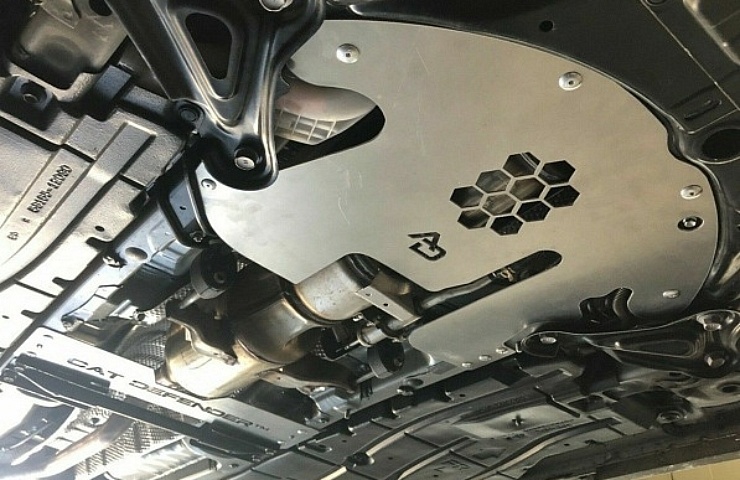Contents
Thefts of catalytic converters are on the rise—an increase of about ten-fold since 2018. Can a catalytic converter lock or shield reduce the risk of theft?
Shop now for catalytic converter shields
Catalytic Converters Reduce Emissions

A stolen catalytic converter can net $150 or more.
The catalytic converter is a small chamber that converts noxious engine exhaust into less harmful fumes. The device is positioned between the engine and the muffler.
Catalytic converters became standard equipment for cars in the mid-1970s. Harmful exhaust, such as carbon monoxide, is routed through the catalytic converter, where a chemical reaction occurs. Thanks to a small amount of precious metals—such as rhodium, palladium, and platinum—the toxic gases are converted to harmless by-products, such as steam.
Each catalytic converter has precious metals worth around $150, depending on the market. In some cases, a catalytic converter from an expensive vehicle can be worth several hundred dollars.
The catalytic converter in the Toyota Prius and other hybrids are prime targets for theft. That’s because hybrid gas-electric cars emit fewer toxic fumes. So those precious metals in the catalytic converter are still in good shape—fetching higher prices at scrap centers.
An Expensive Theft

A catalytic cover is usually designed for a specific model. This one is for a Toyota Prius, a common target.
Thieves crawl under a car to commit their crimes as fast as possible. With a portable, battery-operated reciprocating saw, a robber can get away with the catalytic converter in less than two minutes.
To add insult to injury, the bad guys quickly saw off the catalytic converter without considering damage to other parts. Thieves pull off O2 sensor wires and anything else in their way.
Repair bills from a local shop can exceed $1,000. Of course, if you’re handy, you can save money by buying a catalytic converter on eBay and doing your own replacement. However, the goal is to prevent the theft in the first place.
Also see: Try a Catalytic Converter Cleaner Before an Expensive Repair.
Catalytic Converter Shields

A metal plate creates a secure layer of protection over a catalytic converters.
Vendors on eBay Motors offer metal shields that can be installed over the catalytic converters. The metal shields have vents allowing heat from the converter to escape so the device can still do its job.
Thieves want to move as fast as possible. If they see a shield that requires extra time to remove, they commonly move on to easier pickings down the street.
Most shields install with anti-theft screws. Some line up with existing holes in the underbody, while others might require you to drill holes into the frame. You might also opt to weld a shield into place.
Catalytic Converter Locks
Shop now for catalytic converter locks
A cage (or lock) provides steel cables that wrap around the catalytic converter.
Another excellent security option is to install a wire lock around the catalytic converter. This security item is more like a cage. It consists of heavy-duty steel cables that wrap around the converter and the related exhaust components.
A set of metal supports wrap around the diameter of the pipes, and steel cables wrap through the supports. They weave around the catalytic converter, forming a strong layer of protection.
A thief would need to spend considerable effort cutting through all the cables to get to the converter. A bad guy won’t want to take the extra time or make noise. In nearly all cases, one glance at a catalytic converter lock will send away the thief.
Common Sense Security Strategies
Other anti-theft strategies include:
- Install a car alarm system: Many car alarms include a motion sensor so if somebody shakes the car, a siren goes off and triggers a notification to your smartphone.
- Parking in a visible location: If you park in public, try to find a spot where a lot of people can see the car. For example, park near an active business—like a coffee shop. Parking near an external, motion sensing light, perhaps near your driveway, will also scare off many thieves.
- Park against a curb: Positioning your car near a typical squared-off curb can limit how much room a thief has to crawl. There’s always a way to escape but eliminating the easiest routes can be a mild deterrent.
- Engrave your converter: Some authorities suggest engraving your driver’s license number on the converter. That can help identify your converter if a thief is caught with several of them at the scene of the crime. However, engraving is not a perfect solution. Thieves commonly cut open the device to extract the metals. The rest of the unit, including the casing, gets thrown away.
With the cost of precious metals on the rise, many communities will likely see ongoing thefts of catalytic converters. However, you can reduce your risks by installing a shield or lock—or taking a few of these reasonable precautions.





